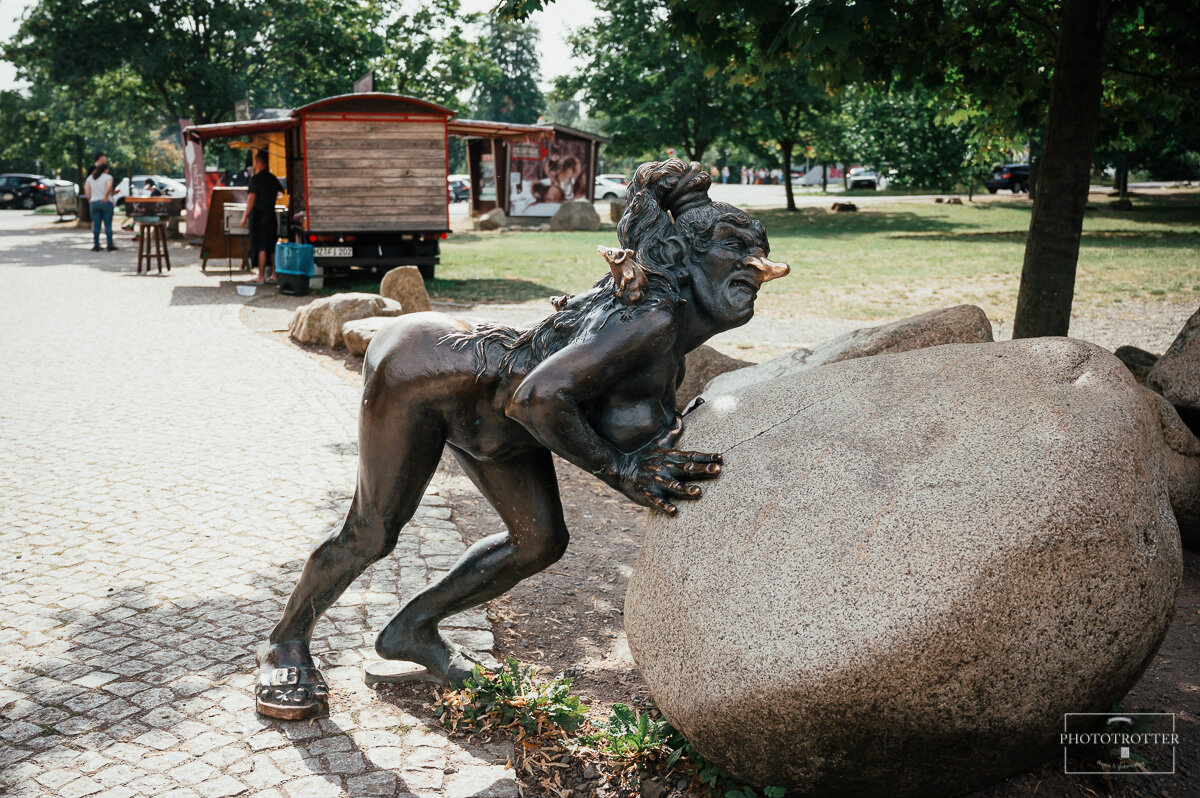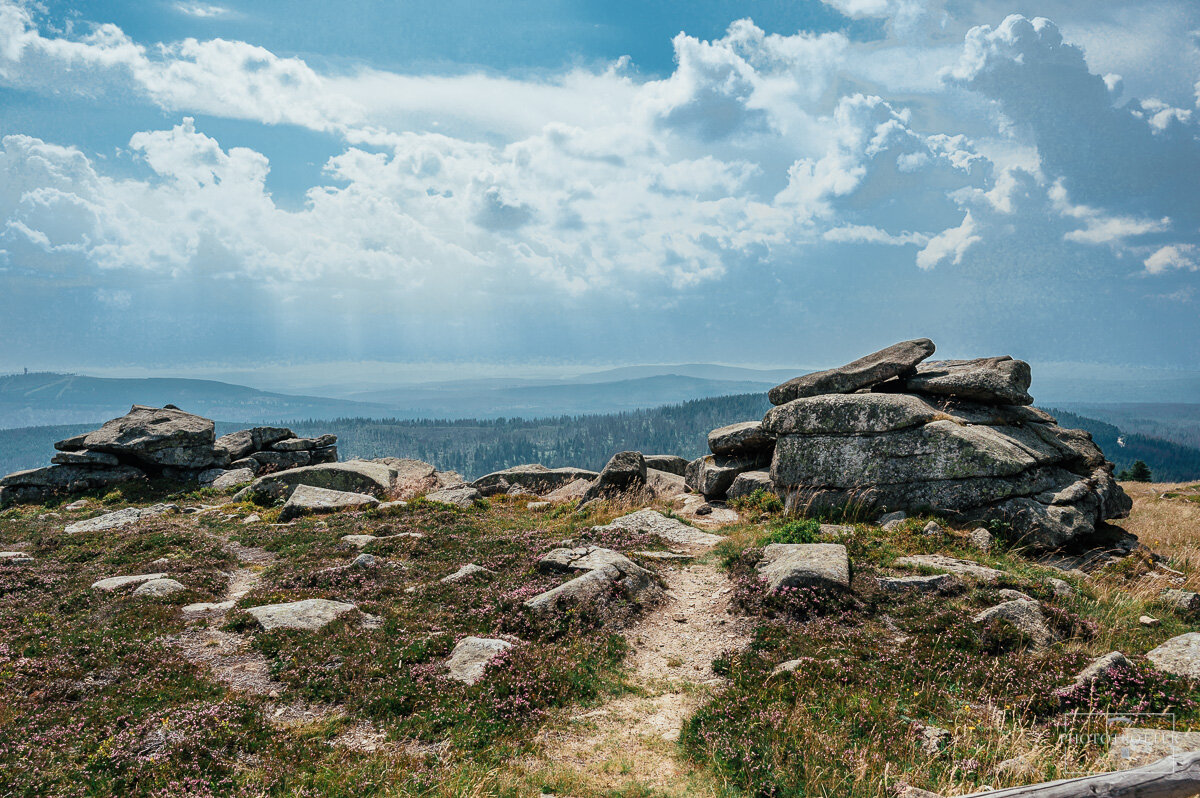Harz Mountains, where witches gather and the devil roams
A long-long time ago, God and the Devil agreed to divide their territories, and the Devil would get the rich Harz Mountains, but only if he could build a wall around it, in just one night, before the rooster’s first crow. And the devil built a mighty stone wall, with tall, jagged black edges.
And as the wall rose, he rejoiced so much at the thought of winning the bet with God, he did a merry little victory jig, before even laying the last stone. His dance dislodged a few rocks, which rolled down on the road below, where a local peasant woman was carring poultry to the town market. She tripped, disturbed the chicken, and the rooster let off a loud ki-ke-ri-kikiiii! The Devil, up on the wall, heard the rooster crow, thought the night has ended and that he lost the bet, and, in a bout of anger, kicked the wall and destroyed it.
This is the story of the Devil’s Wall and Devil’s Dance floor (Teufelsmauer & Teufels Tanzplatz) near Thale, in the Harz.
Not far away, in the neighbouring village of Timmenrode, there’s another broken part of the devil’s wall, alternatively named here Hamburger Wappen, because the three rocky peaks slightly resemble Hamburg’s coat of arms:
A lonely field devil contemplates the bucolic scenery of Timmenrode.
Back to Thale, as you follow the Bodetal, Bode’s valley, into the deep narrow winding gorge, you will find more places where you can hear the devil’s hoofs and the witches’ cackle.
A little further upstream from the Maidens’ Bridge at the King’s Respite, right next to the bubbling Bode Cauldron (Bodekessel, a small waterfall), there’s the Devil’s Bridge, Teufelsbrücke.
And right above it, there’s the Devil’s Pulpit, Teufelskanzel, from where the devil spoke to the witches.
The Bodetal and Teufelskanzel seen from above, at the Rosstrappe.
Not far beyond the Pulpit’s ragged teeth, up on the mountain, there’s a plateau where the witches gather to dance, and that is called Hexentanzplatz.
The legend is more than a thousand years old, from pre-Christian times, when the local Saxon tribes held celebrations for the Hagedissen, the wise women with healing powers. Their name, pointing to the hagen / hedges where they picked their “magic” herbs, later contracted into Hag´sche, then Hex -e, which was preserved in German, as well as English, meaning witch.
The Christian Franks persecuted the pagan culture, wise women/witches included, so the mountain celebration turned, in time, into an evil place where demonic creatures gather for debauchery.
The best thing at the Hexentanzplatz is the Hexenring, a bronze ensemble made by Jochen Müller, a sculptor from Quedlinburg who makes the best fountains and statuaries (a post about his works, coming soon!). Here you can see The Devil himself cackling on a rock, a circumspect homunculus and Watelinde, the Witch Grandmother, pushing a boulder to close the magic evil circle.
Today the place is a fairground, with kitschy-everything-witchy souvenirs, a little zoo, a bob/tobbogan run, a summer theater and a Wallpurgis Hall museum, depicting Goethe’s visions of the Wallpurgis Night of devils and witches from Faust. Which, by the way, took place not on the Witches’ Dance Floor in Thale, but a hop, skip and a jump away, on the mighty Brocken.
If look closely (closer, real’ close) you can see the witches flying… But only on Walpurgisnacht (April 30th). And on Witches’ Sabbath too.
The Brocken. A magical place. Especially if you climb it the long way, on the Heinrich Heine Weg, as we did. 12 km later, after some 3 steep km on a very unfriendly partially-paved road, when you finally see the Brocken’s red-white antenna from up close, it’s indeed like magic!
But leaving aside the whining of pathetic breathless hikers, the Brocken has always been a terrific source for mystic beliefs and dark legends. Goethe, passionate about myths and an enthusiastic mountain hiker, refined some of the pagan folk lore into his works, with a special nod to Faust and the fantastic Walpurgis Night scene, when witches assemble, dance and fly on top of the Brocken.
The actual Brocken top is a wide plateau (since the Brocken is more of a round mound than a sharp-peaked mountain), with some boulders in the center and a ring around it. It is not, however, an evil or a magic Hexenring, because the circle is made up of metal slabs showing the distance to various cities, and the boulder is the climbing magnet for all the children in the area.
Brocken, 1142m.
Of course, the main hiking trail in the Harz Mts. is the Witches’ Ascent, Hexenstieg. Followed closely by the Devil’s Road, Teufelsstieg.
[Read more about the witchy stamps you can collect on the Harz hiking trails here: The Harz Hiking Stamps]
A little further you can see (but not climb, as they are protected) some rock formations enticingly named Witches’ Altar, Hexenaltar and yet another Devil’s Pulpit:
An interesting thing to know about the little mighty Brocken is that it is prone to extreme weather. Despite its size, only 1142m tall, it has a regular alpine climate, going as low as -30 C, with snow for at least 3 months a year and holding a world record of 330 days of fog in 1958.
Having its head in the clouds for so long, it also features a certain spooky phenomenon which has scared people out of their wits for centuries. The Brocken Spectre is the projection of one’s own shadow on the clouds opposing the sun. The result is a colossal haloed silhouette facing you, the weary traveler, trudging up the lonely mountain path. Such frightful apparitions most certainly kept alive the superstition about Brocken’s evil spirits. (Hit wiki for more examples of the eerie phenomenon).
Evil spirits have thus been associated with the Brocken even before Goethe’ s Faust, who picked up some details from local tales and legends, but if you are wondering why is it that the witches only gather during Walpurgisnacht, (and maybe Halloween and several other culturally-relevant and localized Sabbaths), the story brings us back to a woman-saint.
Walpurga was a well-educated English nun and later abbess, who came as a missionary in “Germany” (Franconia, actually, in the 8th century). During her life she had nothing to do with witchcraft (although popular culture does attribute her the powers of protecting from pest, whooping cough and witches), but as it happened, after her death, her canonization took place around the spring/summer celebrations, when huge bonfires were lit for protection against all sorts of evil and misfortunes that might befall the villagers, crops and livestock.
In Celtic areas this tradition of lighting fires to drive away the dark evils of winter is called Beltane festival, and it happens on May 1st. In Germanic areas it blended with St. Walpurga’s celebration, which might have been the result of the church’s deft efforts to transform pagan rituals into Christian observances. After a while, when fires and the possible emergence of evil started to be regularly associated to St Walpurga’s night, it was claimed that witches gather on that night in particular to counteract with their wickedness the saint’s protective powers, who were stronger during her celebration.
If the witchy craze in the Harz might seem to you a silly artifice to give the area a spicy kick, it might help to remember that not so long ago people were tried and killed as witches (the last execution was in the 1780s, and the last trial was in the late 1870s). And while it is not clear from where the witches hail, the witch-hunting manual actually does come from Germany.
Malleus Maleficarum, the Hexenhammer, is a medieval (1487) treaty about witchcraft, a comprehensive guide for methods of recognising, apprehending, interrogating, convicting and killing witches, written by two German Catholic inquisitors, Kramer and Sprenger. Under its guidance in Germany alone over 16000 persons were tried as witches.
No wonder in Germany, and especially in the Harz area, people take their witches seriously. And so should you.
Flying witch in Goslar
Biking witch in Wernigerode
Parking witch in Thale
Souvenir shop witch on an 1684 half-timbered house in Quedlinburg
Welcome to Harz. Here be witches circling the Brocken. Deer too, but circling (and munching) the trees.











